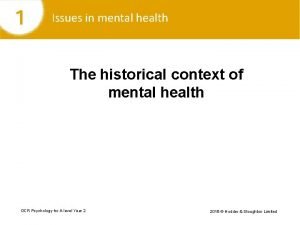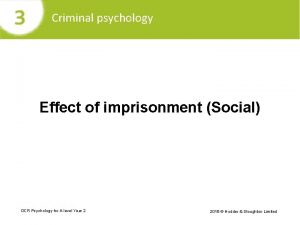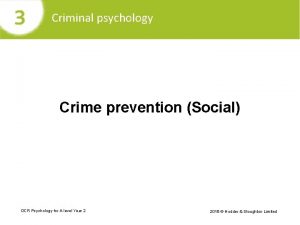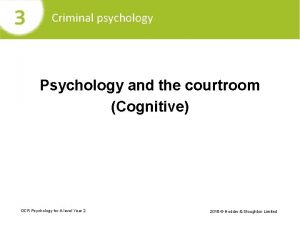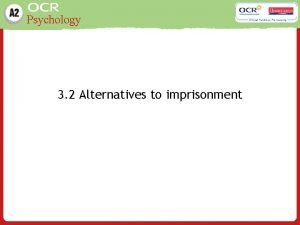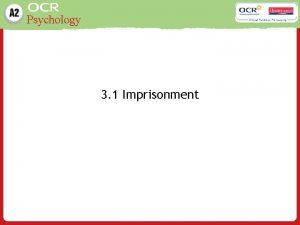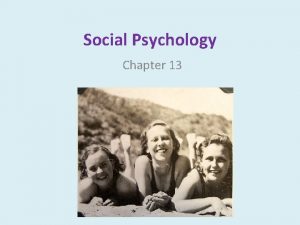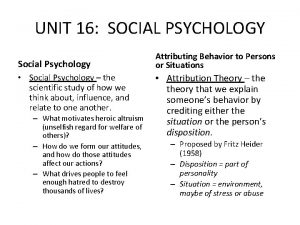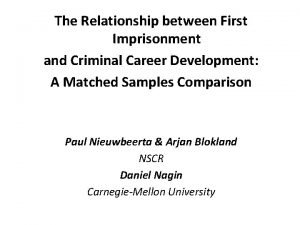Criminal psychology Effect of imprisonment Social OCR Psychology






















- Slides: 22

Criminal psychology Effect of imprisonment (Social) OCR Psychology for A level Year 2 2016 © Hodder & Stoughton Limited

Criminal psychology Background OCR Psychology for A level Year 2 2016 © Hodder & Stoughton Limited

Criminal psychology What is the purpose of prison? • Prison is one of the most commonly thought of punishments that is given to criminals who have been found guilty. • Sentences can vary between long-term stays for serious crimes to the more common shorter sentences for less serious crimes. • But what do we hope to achieve by sending criminals to prison? • This section will investigate imprisonment as a response to criminal behaviour and methods used to rehabilitate offenders. OCR Psychology for A level Year 2 2016 © Hodder & Stoughton Limited

Criminal psychology Imprisonment as an example of punishment What are the reasons why prison is seen as a punishment? • Criminals are locked away from their friends and family (who are only allowed short visits). • They are allowed very few personal possessions. • They usually share a cell with an inmate. • They have to follow a strict regime of rules. Breaking these rules means further punishments within prison. • What time they wake, what they wear and what they eat are controlled for them. • Unintended consequences can include overcrowding, boredom, anxiety and depression. OCR Psychology for A level Year 2 2016 © Hodder & Stoughton Limited

Criminal psychology Is prison effective? • It could be argued that keeping prisoners out of the public is effectively stopping further crimes from being committed as they are locked up. • Locking up criminals does give a sense of justice to the victims and general public. • However, there are serious consequences. Prison can have an impact on the mental health of criminals. • Dooley (1990) reported that the suicide rate of prisoners is four times that of the general public. Younger offenders are particularly at risk. OCR Psychology for A level Year 2 2016 © Hodder & Stoughton Limited

Criminal psychology Prison as deterrent • • • Advocates of the prison system argue that prison is an effective deterrent against further crime. Behaviourists would explain that prison uses operant conditioning. Criminals are punished for negative acts and then when released are negatively reinforced. Unfortunately, criminals do reoffend once leaving prison. Statistics show that reoffending or recidivism rates are high which suggests a failure in the prison system. However, prison works as a vicarious negative reinforcement, where the general public see others go to prison and are aware of the potential consequences if they act in a similar way. Again, statistics suggest that this is not the case with prison populations steadily increasing year on year – suggesting that more people are committing crimes. OCR Psychology for A level Year 2 2016 © Hodder & Stoughton Limited

Criminal psychology Prison as a response to criminal behaviour • Although some prisoners reoffend, some argue that this is not what criminals want to do and that other factors lead them back to a life of crime. • Pakes and Pakes (2009) state that prisoners lose jobs, properties and even contact with family while in prison. • In addition, many prisoners are unskilled, lacking basic numeracy and literacy skills that make it difficult for ex-convicts to find stable work outside of prison. OCR Psychology for A level Year 2 2016 © Hodder & Stoughton Limited

Criminal psychology Prison Programmes Some prison programmes have been created to help prisoners train and prepare for life outside of prison. These include: • Classes to increase skills such as literacy and numeracy. • Training for employment upon release. • Training criminals for jobs as it gives them the income they need to secure accommodation, be independent and increase their selfesteem. Christa Gillis and Mark Nafekh (2005) investigated whether planned employment programmes for prisoners would reduce the amount of reoffending. OCR Psychology for A level Year 2 2016 © Hodder & Stoughton Limited

Criminal psychology Gillis and Nafekh (2005) • • • Gillis and Nafekh compared two groups of participants. One was ex-convicts who had been on a prison employment programme and the other was exconvicts who had not been on a programme. Participants were matched on gender, risk level, family and substance abuse. Participants’ data was collected from Canada’s offender management system and data from 23, 525 prisoners was collected. Results showed that 70% of the prisoners on the employment programme did not reoffend, while only 55% of the non-programme prisoners did not reoffend. The criminals who did reoffend took on average 37 months to do so if they were on the employment programme while the non-programme criminals took an average of just 11 months to reoffend. Giles and Nafekh conclude that a planned programme that allows prisoners to work is one way of reducing reoffending rates. OCR Psychology for A level Year 2 2016 © Hodder & Stoughton Limited

Criminal psychology Key research: Haney et al. (1973) Study of prisoners and guards in a simulated prison OCR Psychology for A level Year 2 2016 © Hodder & Stoughton Limited

Criminal psychology Background • • • Some people think that brutal and harsh prisons are useful to teach criminals a lesson. Haney et al. found that US prisons in the 1970 s went beyond what would be considered fair, finding that inhumane practices like physical and sexual abuse occurred inside US prisons. There could be two reasons why the prison system had turned out this way: 1. The people who choose to become guards are by nature aggressive people who act in this way (dispositional hypothesis). 2. The organisation and structure of a prison causes people to work in them to become more aggressive (situational hypothesis). OCR Psychology for A level Year 2 2016 © Hodder & Stoughton Limited

Criminal psychology Aim • The study wanted to investigate whether aggression shown by prison guards is due to their nature (disposition) or the prison environment (situation). • To do this a new ‘mock’ prison was set up in Stanford University’s basement (a real prison could not be used for ethical or practical reasons). • The researchers used regular men and randomly divided them into the role of ‘prisoner’ or ‘guard’. • They predicted that the role each participant was given would determine their behaviour rather than their individual personality. OCR Psychology for A level Year 2 2016 © Hodder & Stoughton Limited

Criminal psychology Participants • • • A newspaper advertisement was placed asking male volunteers to take part in a study of prison life for $15 a day. 75 participants completed questionnaires about their family background, physical and mental health and involvement in crime. Participants also were interviewed. 24 men were finally selected as they were judged to be physically and mentally stable, mature and least involved in antisocial behaviours. All participants were college students in the Stanford area for the summer. The majority of participants were white and middle class. Participants were screened to ensure that they did not know each other. This made the study more ethical as pre-existing friendships were not at risk and also more valid as no previous relationships would impact on the results. OCR Psychology for A level Year 2 2016 © Hodder & Stoughton Limited

Criminal psychology Procedure: Instructions to participants • Participants were told they would be randomly assigned to ‘guard’ or ‘prisoner’. • The study was due to last 14 days and they would be paid $15 a day. • Participants signed a contract that informed them that they would be under surveillance, and prisoners were told that some of their civil rights would be suspended (with the exception of physical abuse). OCR Psychology for A level Year 2 2016 © Hodder & Stoughton Limited

Criminal psychology Guards • Guards wore a khaki shirt and trousers. (To suggest a military attitude. ) • They carried a whistle and police night stick. (Symbols of power and control. ) • They wore reflective sunglasses. (So no eye contact was possible. ) • They were told their task was to maintain a reasonable degree of order and to not let the prisoners escape. • They were told to work 3 -man, 8 -hour work shifts. • They were deliberately given minimal other instructions other than being told it was absolutely unacceptable to use physical punishment. • Prisoners referred to guards as ‘Mr Correctional Officer’. OCR Psychology for A level Year 2 2016 © Hodder & Stoughton Limited

Criminal psychology Prisoners • • Prisoners were ‘arrested’ at their home by real Palo Alto police officers. They were handcuffed and taken to a police station. The police officers did not answer whether this arrest was part of the study or not. Prisoners were then collected from the detention cell by one of the guards and taken to the mock prison. There they were made to strip, sprayed with deodorant spray (a ‘delousing preparation’) and made to stand naked in the yard for a while. A mug shot was taken and the prisoner was then moved to a cell and told to be silent. Each prisoner was referred to by their prisoner number. They wore loose-fitting muslin smocks with their number on the front and back. These frocks were designed so prisoners had to adopt ‘female’ postures as no underwear was worn. A light chain was worn on one ankle (to symbolise oppression and restriction). Rubber sandals and a cap made from a nylon stocking were also worn (designed to be humiliating and deindividuating). OCR Psychology for A level Year 2 2016 © Hodder & Stoughton Limited

Criminal psychology Results • • The study had a dramatic effect on behaviour. The study was scheduled for 14 days but was stopped after 6 days. An initial revolt by prisoners on day one was quickly stamped out by guards. After this the prisoners’ mood flattened as they showed passivity and dependence. Five prisoners had to be released due to extreme emotional depression, crying, rage and anxiety. These symptoms began at day two. Another prisoner developed a rash that the researchers believed was psychosomatic. All but two of the prisoners asked if they were allowed to leave the study if they forfeit the money that had been given. When told the request would be considered they went back to their cells (when they could have simply walked out). The researchers believe this was because the prisoners believed that the environment was now a real prison. The guards were verbally abusive to prisoners and were quick to humiliate and torment the prisoners (although not all guards did this). OCR Psychology for A level Year 2 2016 © Hodder & Stoughton Limited

Criminal psychology Conclusions: Guards • The authors conclude that the behaviour shown by guards and prisoners was due to the environment of the prison rather than their individual personalities. • The guards’ behaviour was described as a pathology of power that develops when people are given the opportunity to exert power over others. • In addition, the guards’ personal identities were individuated due to the role they had, clothes they had to wear and instructions they were given. This could have meant they did not feel responsible for their own behaviour. • Haney et al. conclude that the behaviour of the guards was dictated by their role. OCR Psychology for A level Year 2 2016 © Hodder & Stoughton Limited

Criminal psychology Conclusions: Prisoners The deterioration of the prisoners’ mental state could be explained in several different ways: • Like the guards, prisoners had a loss of personal identity (only being referred to by number, clothes they wore, etc. ). • The arbitrary control exerted by the guards meant the prisoners learned they could not help themselves. • Prisoners were emasculated by the clothes they wore and were dependent on the guards. OCR Psychology for A level Year 2 2016 © Hodder & Stoughton Limited

Criminal psychology Application: Strategies for reducing reoffending OCR Psychology for A level Year 2 2016 © Hodder & Stoughton Limited

Criminal psychology How can you reduce reoffending? • You need to be able to suggest at least one strategy for reducing reoffending. • You have looked at two strategies so far: 1. Prisons as punishments and deterrents. 2. Community-based employment programmes (as described by Gillis and Nafekh). • A further strategy that you could use is called restorative justice. OCR Psychology for A level Year 2 2016 © Hodder & Stoughton Limited

Criminal psychology Restorative justice • • • Restorative justice is unique because it focuses on the needs of the victim, rather than just simply punishing the offender. In restorative justice the victim and offender meet with trained officials and support (friends, family) for each side. In this meeting the offender usually apologies for committing the crime, and offers to make amends for what has been done. This can be drug rehabilitation programmes and includes signing contracts to make their decision formal. In turn, the victim has a chance to speak about what impact the offence has had on them. They can have the harm that has been done to them acknowledged in a way that the criminal justice system does not usually allow. This process is called a restorative justice process. The victim can ask questions about why they were chosen to be the target of a crime and can often feel reassured if they find out that the reason they were targeted was because they were just in the wrong place at the wrong time rather than for a more personal reason. Restorative justice is not an alternative to punishment and both parties must, in full agreement, voluntarily enter the process. OCR Psychology for A level Year 2 2016 © Hodder & Stoughton Limited
 Wjec criminology unit 4 revision
Wjec criminology unit 4 revision False imprisonment in healthcare
False imprisonment in healthcare Example of false imprisonment
Example of false imprisonment Cofeposa act
Cofeposa act Criminal justice funnel
Criminal justice funnel Historical views of mental illness psychology ocr
Historical views of mental illness psychology ocr Ocr psychology research methods
Ocr psychology research methods Ocr health and social care level 2
Ocr health and social care level 2 Ocr health and social care
Ocr health and social care Ocr health and social care
Ocr health and social care Ocr key dates
Ocr key dates Cambridge technicals level 3 health and social care unit 2
Cambridge technicals level 3 health and social care unit 2 What is criminal psychology definition
What is criminal psychology definition Definition of criminal psychology
Definition of criminal psychology Organized nonsocial offender
Organized nonsocial offender Georgia court competency test
Georgia court competency test Psychology experiment
Psychology experiment Fundamental attribution error ap psychology
Fundamental attribution error ap psychology Social psychology is the scientific study of
Social psychology is the scientific study of Social thinking and social influence in psychology
Social thinking and social influence in psychology Apa itu social thinking
Apa itu social thinking Social thinking social influence social relations
Social thinking social influence social relations Bohr's effect in respiration
Bohr's effect in respiration





